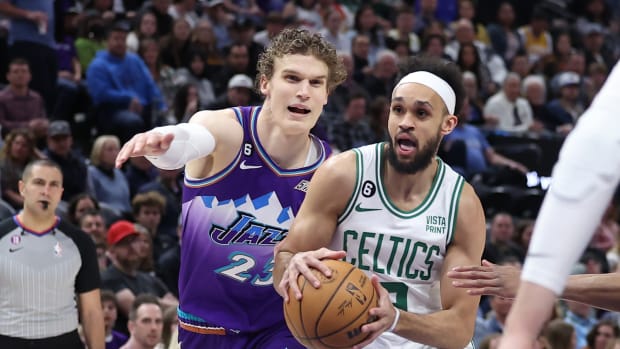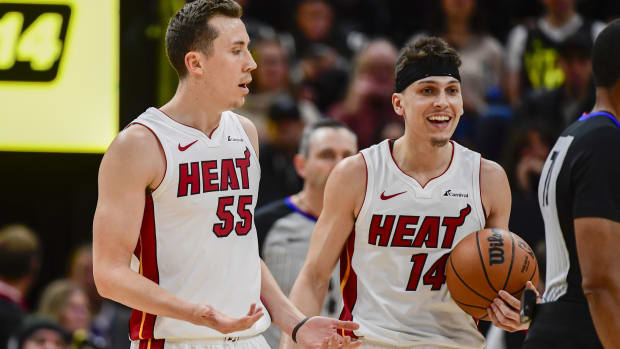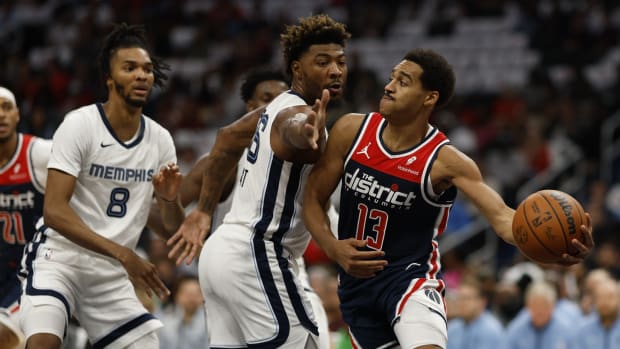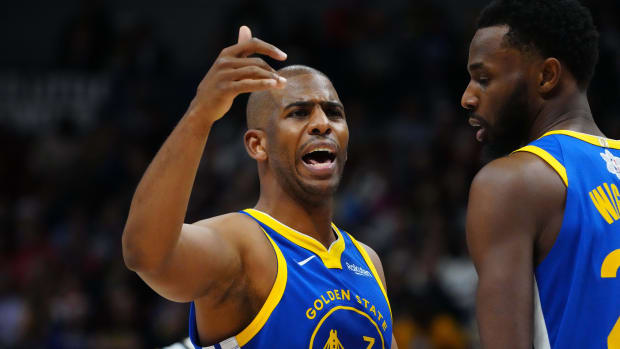Lin's game still has flaws, but stats show his rise to stardom is no fluke
The first ingredient in Lin's meteoric rise to stardom is his phenomenal ability to get to the basket. Among players with at least 75 attempts within 6 feet of the rim, the only point guards who take a higher percentage of their total shots from that range are Boston's Rajon Rondo and Sacramento's Tyreke Evans (if you consider him a point guard). And while both Rondo's and Evans' short-range field goals are assisted more than a quarter of the time (meaning a teammate created the high-percentage opportunity for them), Lin is creating those attempts all by his lonesome -- only 10.3 percent of his field goals within 6 feet have been assisted. With a 51 percent conversion rate on close shots (which make up more than 55 percent of Lin's total attempts), it's easy to see why the Knicks' phenom is shooting 50 percent from the field, seventh among guards with at least 135 tries.
In addition to setting up high-percentage shots in the lane, Lin's quick first step and attacking style naturally lead to a large number of free throws, which are great for enhancing offensive efficiency (the league averages 76 percent more points on possessions ending in free throws than on non-free-throw possessions). Per 100 field-goal attempts, Lin is attempting a staggering 52.4 free throws, an exceptional rate for a backcourt player. Among guards, only Oklahoma City's James Harden (63.3) and Detroit's Rodney Stuckey (54.7) have better ratios of free-throw attempts to field-goal attempts than Lin. Although he's shooting only 75 percent at the line -- a mark that ranks 38th out of 43 guards with at least 70 attempts -- Lin is making enough to boost his efficiency, given the frequency with which he draws fouls.
But perhaps the 23-year-old's greatest contribution to the Knicks' offense has been his playmaking ability. Early in the season, New York employed a number of non-passers at point guard, including rookie Iman Shumpert (who assists on a paltry 18.7 percent of teammate field goals when on the court), Toney Douglas (also 18.7 percent) and Mike Bibby (15.8 percent). This led to coach Mike D'Antoni's using noted ball-stopper Carmelo Anthony -- he of the career 15.5 percent assist rate going into 2012 -- as the team's main distributor, in a point-forward role.
The results were predictably bad, as the offense stagnated in the absence of a true playmaker. But after the 6-foot-3, 200-pound Lin assumed the mantle of New York's primary point guard seven games ago, the team's scoring output has improved from 1.011 points per possession to 1.052, in no small part because Lin has a healthy 51.5 percent assist rate, second highest in the league behind Steve Nash's 58.7 percent. This development shouldn't be too surprising: Research on the individual stats most associated with on-court impact consistently finds that assists are strongly linked to increased offensive efficiency.
And efficiency has definitely been the name of Lin's game during his recent run. His true shooting percentage, which measures the average number of points a player generates per possession when he shoots, compares favorably to that of other star players. Moreover, according to the formula for offensive efficiency from Dean Oliver's book Basketball on Paper, Lin is producing 1.073 points per possession for the Knicks (compared to the league average of 1.03), and is using 33.2 percent of New York's possessions while on the floor, one of the highest usage rates in the league. Only two players -- the Lakers' Kobe Bryant (36.2 percent) and the Thunder's Russell Westbrook (33.7 percent) -- shoulder a greater proportion of their team's offensive burden than Lin has this season, and Lin's offensive efficiency is considerably better than either Bryant's (1.049 points per possession) or Westbrook's (1.031).
The only players in the NBA to use more than 30 percent of team possessions and post better efficiency marks than Lin? Heat teammates LeBron James (33.1 percent of possessions, 1.189 points per possession) and Dwyane Wade (31.1 percent, 1.111). So, offensively, Lin is in elite company.
Defensively, Lin's metrics also suggest he's playing at an above-average level. According to 82games.com, opposing point guards have a 15.1 Player Efficiency Rating when matched up with Lin (league average is 15.0), but the Knicks are 5.5 points per 100 possessions of defensive efficiency better with Lin in the game. His career 4.0 steals percentage (the percentage of opponent possessions that end with a steal by the player while he was on the floor) is indicative of a player with the length and athleticism to bother opposing ball-handlers.
Want more evidence of Lin's impact on D? Before he began seeing heavy minutes, New York was allowing 1.018 points per possession, but that number has dropped to 0.962 since Feb. 4 (to put that number in perspective, consider that the team with the best defense, Philadelphia, has allowed 0.968 points per possession this season). Because of these factors, Lin's regularized adjusted defensive plus/minus rating is plus-0.2, placing him above the league average (and far above the average for point guards, who tend to rate negatively on defense in plus/minus systems).
Despite his remarkable success over the past two weeks, though, Lin's game is not without its holes. There are still concerns over jumping to wild conclusions about his true ability after such a small sample of games. It's easy to forget that Lin has played just 34 more minutes in 2012 than he did as a rookie in 2011, when he posted an unimpressive 14.8 PER and minus-1.1 regularized plus/minus. Nate Silver wrote a great piece in The New York Times about the confidence we can have in Lin's true ability, despite the small sample, because of the magnitude of his accomplishments. This is true to a degree, but some wariness is still in order for an undrafted player who entered 2011-12 with a career shooting mark of 38.9 percent.
It's also fair to point out Lin's propensity for turnovers. This season, 21.8 percent of Lin's individual possessions have ended with him committing a turnover, 16th most among guards with at least 159 minutes. Lin's turnovers tend to come in bunches, too. He already has two eight-turnover games, to go with three more games in which he turned the ball over six times.
This isn't a huge problem for a top point guard; Nash's turnover rate is 23.8 percent, the fifth consecutive season he's been above 21 percent. But Lin's effective rate of assists to turnovers, as shown by John Hollinger's Pure Point Rating (used to measure a player's passing and ball-handling), tells us that his floor game isn't really on the same level as a point guard like Nash. This season, Nash's pure point rating is 11.0, third in the league behind Toronto's Jose Calderon (11.5) and the Clippers' Chris Paul (11.2), and he's been above 9.3 every season since joining the Suns in 2004-05. Lin's pure point rating, on the other hand, is 2.8, which ranks 44th in the NBA. For Lin to truly join the ranks of the elite point guards, he'll have to improve his decision-making with the ball and keep the giveaways to a minimum.
Then there's the matter of Lin's jump shot, a source of worry ever since he entered the draft in 2010. Lin is not the purest shooter in the world; much has been made of his unorthodox mechanics, which are made apparent with his career 75.3 free-throw percentage and 24 percent mark from three-point range, both below average for guards. Even in college, where Lin shot an impressive 48 percent from the floor -- including better than 50 percent in his final two seasons -- his career three-point shooting was 33.3 percent (from the short NCAA distance) and his free-throw shooting was 73.3 percent, both consistent with the numbers he's posted in the pros. During this magical season, Lin is knocking down an unsustainable 59.1 percent of mid-range jumpers, but that is a rate that will inevitably regress to the mean, given the rest of his shooting résumé (he made just 29 percent of the same shots a year ago).
But a natural regression does not mean the "Linsanity" has to end. For now, New York has no reason to give the point-guard keys to anyone except Lin, especially in light of the abysmal offensive performances from Shumpert, Douglas and Bibby this season. And it's hard to envision a rusty, 32-year-old Baron Davis seriously challenging for point-guard minutes when he returns from injury, even if Lin's skill level isn't as high as his most recent seven-game sample would have us believe.
If the magic of Lin's run has taught us anything, it's that he is a legitimate NBA player with strong playmaking skills and the ability to create his own shot. His stats probably won't stay in LeBron's and Kobe's territory forever, but point guards who fit that profile tend to have productive careers in the league.



































